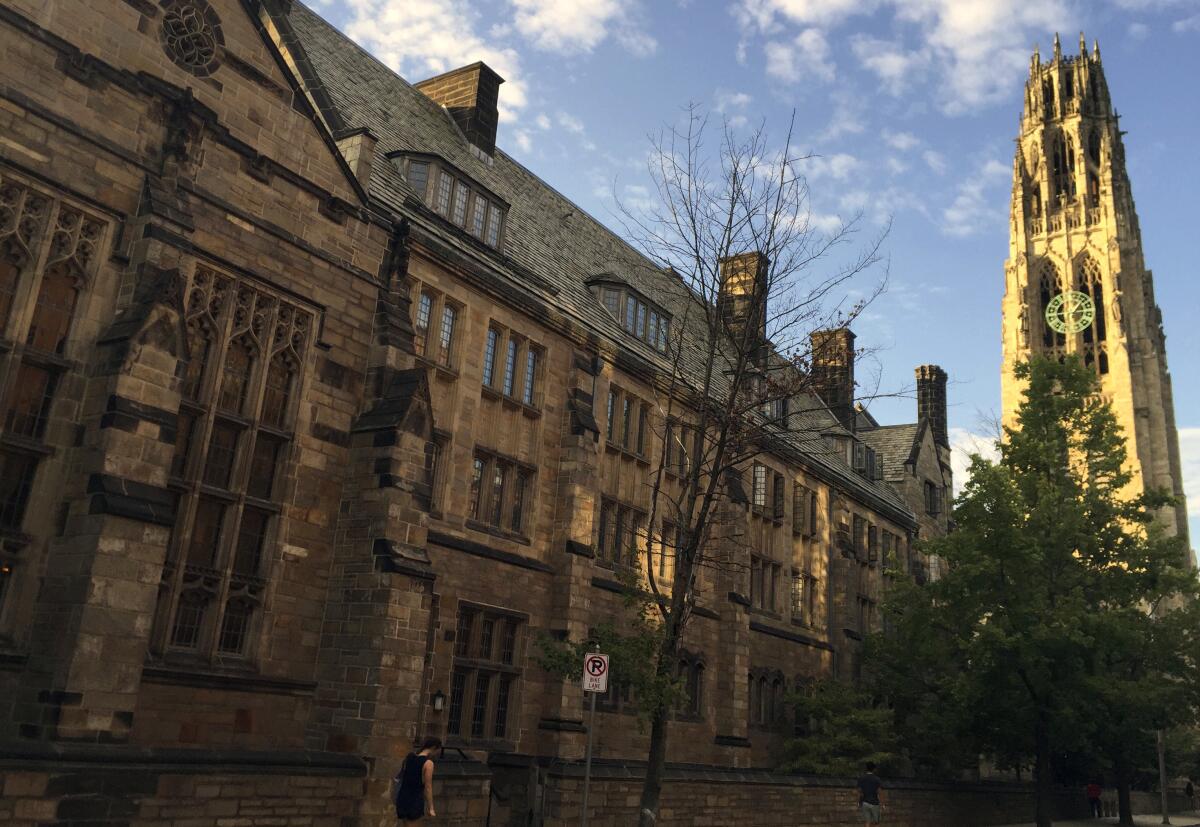Op-Ed: The real affirmative action dominating admission to elite colleges benefits privileged white kids

- Share via
This month, the Justice Department accused Yale University of discriminating against Asian and white applicants to favor other groups, willfully ignoring historical inequities in education and the systemic racism that fuels those inequities. In the fight over affirmative action, this false narrative — pitting Asian applicants against Black and Latinx ones — has become a standard tactic.
Framing college admissions as a fight between marginalized groups ignores the complex set of structures that benefit wealthy white applicants at selective universities like Yale. For all of Yale’s rhetoric about defending diversity, it continues to give special treatment to the children of alumni (legacies) and applicants related to major donors — the great majority of whom are white. If these schools truly cared about dismantling inequality, they would have ended these practices long ago. At the same time, the Justice Department is entirely silent on this form of affirmative action.
Harvard, similarly, has been embroiled in a long-running lawsuit which claims that Asian Americans are discriminated against through the university’s use of race as a factor in its admissions process. Over the course of that lawsuit, the public has been given a rare glimpse into its closed-door admissions process through a wealth of new data and documents. The astounding truth revealed in that litigation? The huge advantage routinely granted to wealthy white applicants.
An analysis of the Harvard data from that lawsuit, published last year by the National Bureau of Economic Research, showed that 43% of white students admitted to Harvard between 2009 to 2014 were either recruited athletes, legacies, applicants on the “dean’s interest list” (those connected to donors), and children of faculty and staff, categories that are considered favorably in admissions. Among Black, Latinx and Asian students admitted, less than 16% of each group benefited from those preferences.
The study also revealed, more shockingly, that 75% of the white students who were admitted under one of these privileged categories would have been rejected had they not been given those bonus points. It concluded that “removing preferences for athletes and legacies would significantly alter the racial distribution of admitted students,” with the share of white admittees falling and all other groups rising or remaining unchanged. It also notes that the admissions advantage for athletes and legacy applicants has increased substantially over the past 20 years.
This is the real affirmative action that dominates admission to colleges like Harvard and Yale, one that offers those with privilege and resources an even greater advantage than they already have. Those who want to talk about academic “meritocracy” in admissions (if it exists at all) should be focusing on the real problem at hand: why less qualified, wealthy white students are essentially given spots that should be available to all applicants.
Casting affirmative action as a battle between marginalized groups, however, is an easy distracting lie that the Justice Department is perpetuating and one that places like Yale continue to tolerate.
This isn’t surprising. Legacy admissions, which give the children of alumni at Yale an admissions bump and serve as tiebreakers between equally qualified candidates at places like Brown, were created to preserve elite colleges as bastions of wealthy, white privilege. Roughly 42% of private institutions consider alumni connections as a factor in admissions, even though it disproportionately benefits white applicants. At Harvard, almost 70% of all legacy applicants are white.
The dean’s special category is shrouded in even more mystery. At Yale, 30 to 40 students each year receive an “institutional distinction” that gives them a boost for admission, according to the Yale Daily News. Donors’ children may also receive preferential treatment as VIPs that include campus tours organized by the office of development.
The Harvard Crimson has reported that applicants on the “dean’s interest list” benefited from a “significantly inflated acceptance rate.” Students on the dean’s list and the similar “director’s” list combined made up a whopping 9.34% of Harvard admittees over the course of six years. During that period, applicants on those two lists had a 42.2% acceptance rate compared with the typical 4% to 5% admissions rate in recent years.
It’s easy to ignore all of this when the debate about affirmative action is so narrowly defined that we fail to discuss the structural discrimination built into admissions decisions. We’ll surely witness this failure when the case challenging Harvard, backed by the Justice Department, is heard in a federal appeals court in September.
The DOJ should be condemned for its attacks on affirmative action — and so should Yale, Harvard and other selective universities for policies that continue to shamelessly benefit the most privileged.
Katherine Hu is a senior at Yale College and a former intern at the Los Angeles Times.
More to Read
A cure for the common opinion
Get thought-provoking perspectives with our weekly newsletter.
You may occasionally receive promotional content from the Los Angeles Times.









